As an Amazon Associate KitchenwareSets.com earns from qualifying purchases.
Farmhouse Kitchen Cabinets 11 Ideas For Cozy Modern Kitchens
Dreaming of a kitchen that’s both cozy and chic? You’re not alone. Many of us want a space that feels like the warm, welcoming heart of the home, but without sacrificing modern style and functionality. It’s a place for lazy Sunday breakfasts, chaotic family dinners, and quiet morning coffees.
The challenge is striking that perfect balance. How do you create a kitchen that feels both timelessly rustic and refreshingly contemporary? You want the charm of a country farmhouse but the clean lines and practicality needed for today’s busy life. It’s easy to get lost in a sea of inspiration, unsure how to translate those beautiful images into a real, livable space.
The solution lies in the modern farmhouse aesthetic, and its cornerstone is the right choice of kitchen cabinets. We’ve analyzed hundreds of today’s most popular designs and consulted with interior style guides to distill the essential elements that define a truly successful modern farmhouse kitchen. Get ready to discover 11 inspiring and actionable cabinet ideas that will help you create the warm, inviting, and highly functional kitchen you’ve been dreaming of.
What Defines Modern Farmhouse Kitchen Cabinets?
Modern farmhouse cabinets are defined by their simple, practical design, most commonly the Shaker style, which features a flat central panel and a raised square frame. They embody a blend of traditional craftsmanship and modern simplicity. The key is in the details that create a look that’s both rustic and refined. We find their popularity comes from their ability to feel both classic and current.
- Simple, Practical Construction: The Shaker-style cabinet is the undisputed star. Shaker doors are popular because their simple, unadorned design embodies the farmhouse principles of practicality and craftsmanship. Their clean lines provide a perfect canvas for various colors and hardware.
- Neutral & Natural Color Palette: While classic white remains a favorite for its bright and airy feel, modern farmhouse design embraces a broader range of colors. Think warm whites, soft grays, greige, and earthy, nature-inspired tones like sage green or even moody navy blue.
- Emphasis on Natural Wood: Whether used for all the cabinetry or as a warm accent for an island or shelving, natural wood is essential. Lighter woods like white oak or rustic reclaimed pine add texture and warmth, connecting the kitchen to its natural roots.
- Durable, Understated Hardware: You won’t find ornate, shiny hardware here. Modern farmhouse style favors simple, durable hardware with a handcrafted feel. Matte black, oil-rubbed bronze, and unlacquered brass are top choices, often in the form of cup pulls, simple knobs, or bar pulls.
11 Farmhouse Kitchen Cabinet Ideas for a Cozy, Modern Makeover in 2025
Ready for a transformation? Whether you’re planning a full renovation or looking for a simple weekend update, these curated ideas offer something for every style and budget. These 11 ideas are curated from top interior designers and the most-loved kitchens on Pinterest, ensuring they are both on-trend and timeless. Each one is designed to help you craft a warm, modern, and beautiful kitchen that feels uniquely you.
https://www.pinterest.com/pin/33-modern-farmhouse-kitchen-ideas-blending-rustic-charm-with-contemporary-design-video-in-2025–1101904233817451469/
1. The Timeless Appeal of Classic White Shaker Cabinets
The most classic farmhouse look is achieved with white Shaker cabinets, paired with contrasting matte black hardware and a simple backsplash. This combination is eternally popular because it creates a bright, clean, and airy foundation that you can easily personalize with other decor. It’s a versatile backdrop that works with everything from rustic wood accents to sleek stainless steel appliances.
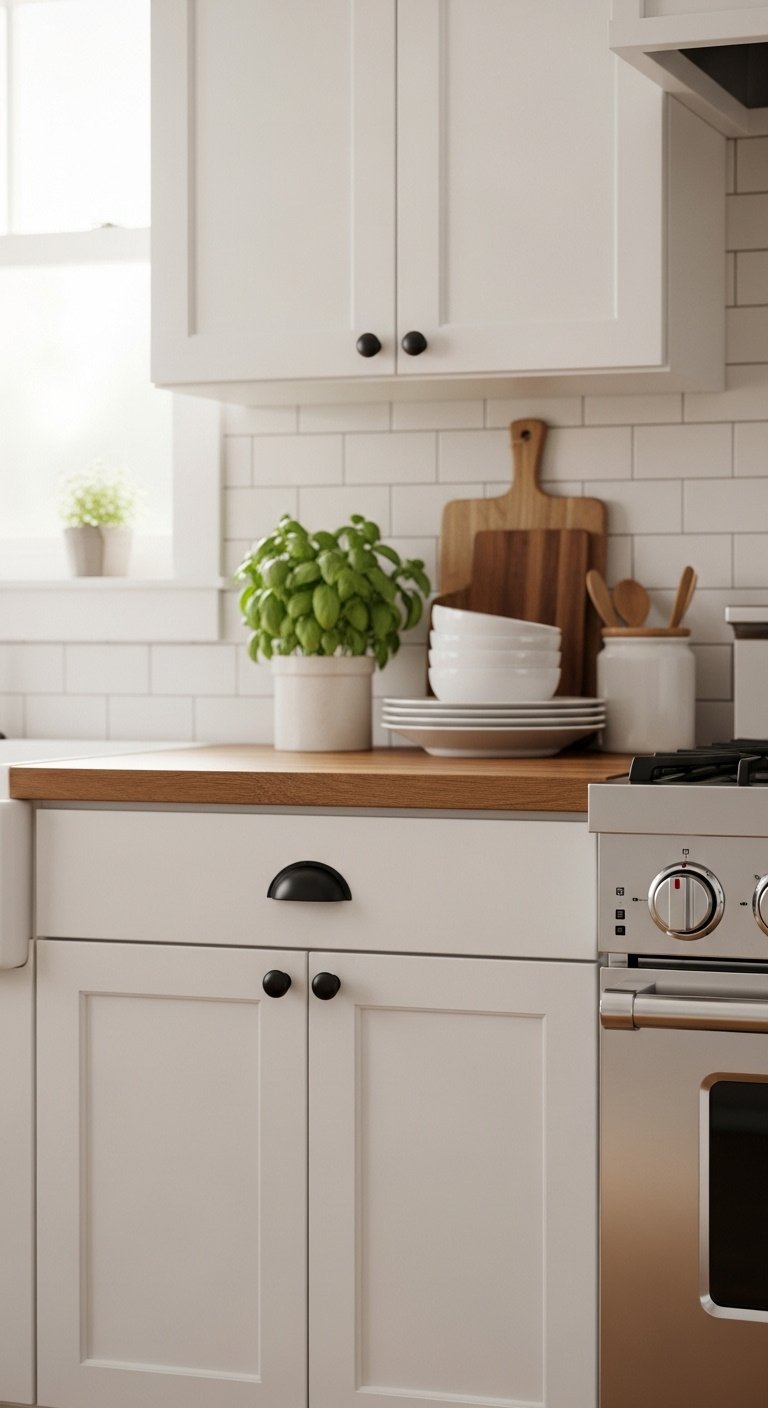
- Materials Needed: High-quality primer, semi-gloss or satin cabinet paint (e.g., Benjamin Moore Simply White or Sherwin-Williams Alabaster), painter’s tape, fine-grit sandpaper, matte black cup pulls or knobs, wood filler.
- Step-by-Step Directions:
- Remove cabinet doors and hardware. Clean all surfaces thoroughly with a degreaser.
- Lightly sand all surfaces to be painted. Fill any holes with wood filler and sand smooth.
- Apply one to two coats of high-quality primer, allowing for proper dry time.
- Apply two to three thin coats of your chosen white paint, sanding lightly between coats for a smooth finish.
- Once fully cured, re-install doors and attach your new matte black hardware.
Pro-Tip: For a truly authentic look, pair your white cabinets with a dark grout on a white subway tile backsplash. This simple detail adds depth and a touch of vintage character.
“Pin this classic look to your ‘Dream Kitchen’ board!”
2. Warmth and Texture with Natural Wood Cabinets
To add organic warmth and texture, opt for natural wood cabinets in a light finish like white oak or knotty pine. This approach moves away from the all-white look and introduces a rich, earthy element. The key is to keep the wood finish light and the door style simple (like Shaker) to maintain a modern feel.
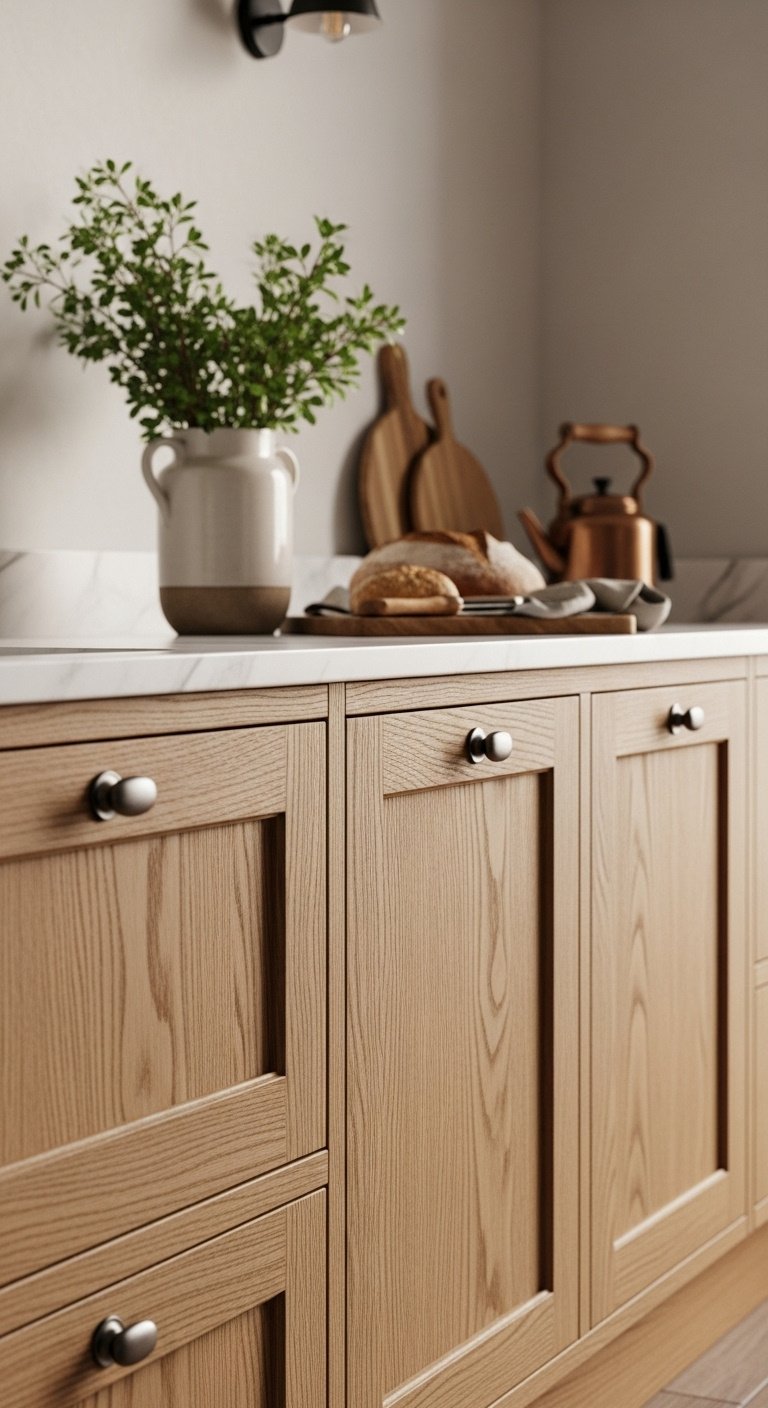
- Materials Needed: Wood cabinets (e.g., white oak or knotty pine), clear matte or satin polyurethane, fine-grit sanding sponge, high-quality natural bristle brush, unlacquered brass knobs.
- Step-by-Step Directions:
- Ensure wood cabinets are clean, dry, and free of dust.
- Lightly sand the surfaces with a fine-grit sanding sponge, moving with the grain.
- Wipe away sanding dust with a tack cloth.
- Apply a thin, even coat of clear polyurethane using long, steady strokes. Avoid over-brushing to prevent bubbles.
- Let it dry completely, then lightly sand again before applying a second coat for maximum durability.
- Install warm brass hardware to complement the beautiful wood tones.
Lesson Learned: To prevent a wood kitchen from looking dated, contrast the warm wood with clean, modern elements like a crisp white quartz countertop and a simple, elegant backsplash.
“Love the natural look? Save this idea to your ‘Rustic Modern’ board!”
3. Two-Tone Magic: A Modern Twist on Tradition
Create instant visual interest and a custom look by using a two-tone cabinet design, typically a light color for the uppers and a darker, grounding color for the lowers or island. This modern take on the farmhouse kitchen adds depth and personality. Popular combinations include classic white uppers with navy, forest green, or gray base cabinets.
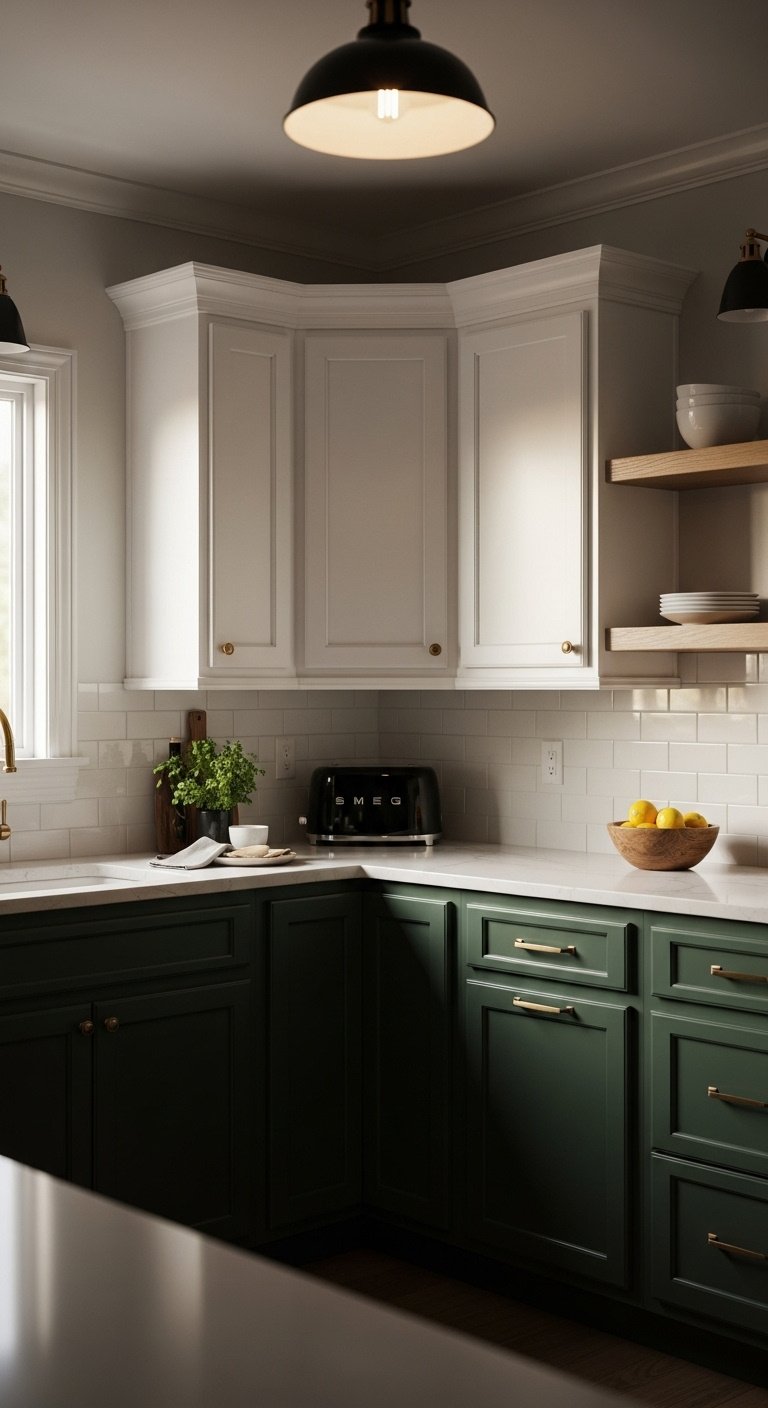
- Materials Needed: Two complementary paint colors (e.g., a warm white and a deep forest green), primer, painter’s tape, high-quality brushes/rollers.
- Step-by-Step Directions:
- Decide on your color placement. The standard is a lighter color for upper cabinets to feel airy, and a darker color for lower cabinets or the island to ground the space.
- Prep and prime all cabinet surfaces as outlined in Idea #1.
- Carefully tape off areas to ensure crisp lines between colors, especially where upper and lower cabinets meet tall pantry units.
- Paint the upper cabinets with your lighter color first. Allow to fully cure before removing tape.
- Paint the lower cabinets or island with your darker color.
- Consider using two different hardware finishes to complement each cabinet color (e.g., matte black on white uppers, and warm brass on green lowers).
Pro-Tip: For a cohesive look in a two-tone kitchen, choose a countertop material that contains flecks or veining of both your chosen cabinet colors to tie the whole design together.
“Ready for a bold change? Pin this two-tone inspiration!”
4. Gentle & Earthy: The Sage Green Farmhouse Kitchen
For a touch of color that feels both natural and sophisticated, choose a soft, muted sage green. This color has become a new neutral in farmhouse design. It’s calming, earthy, and pairs beautifully with natural wood tones, brass hardware, and creamy whites, creating a kitchen that feels serene and connected to nature.
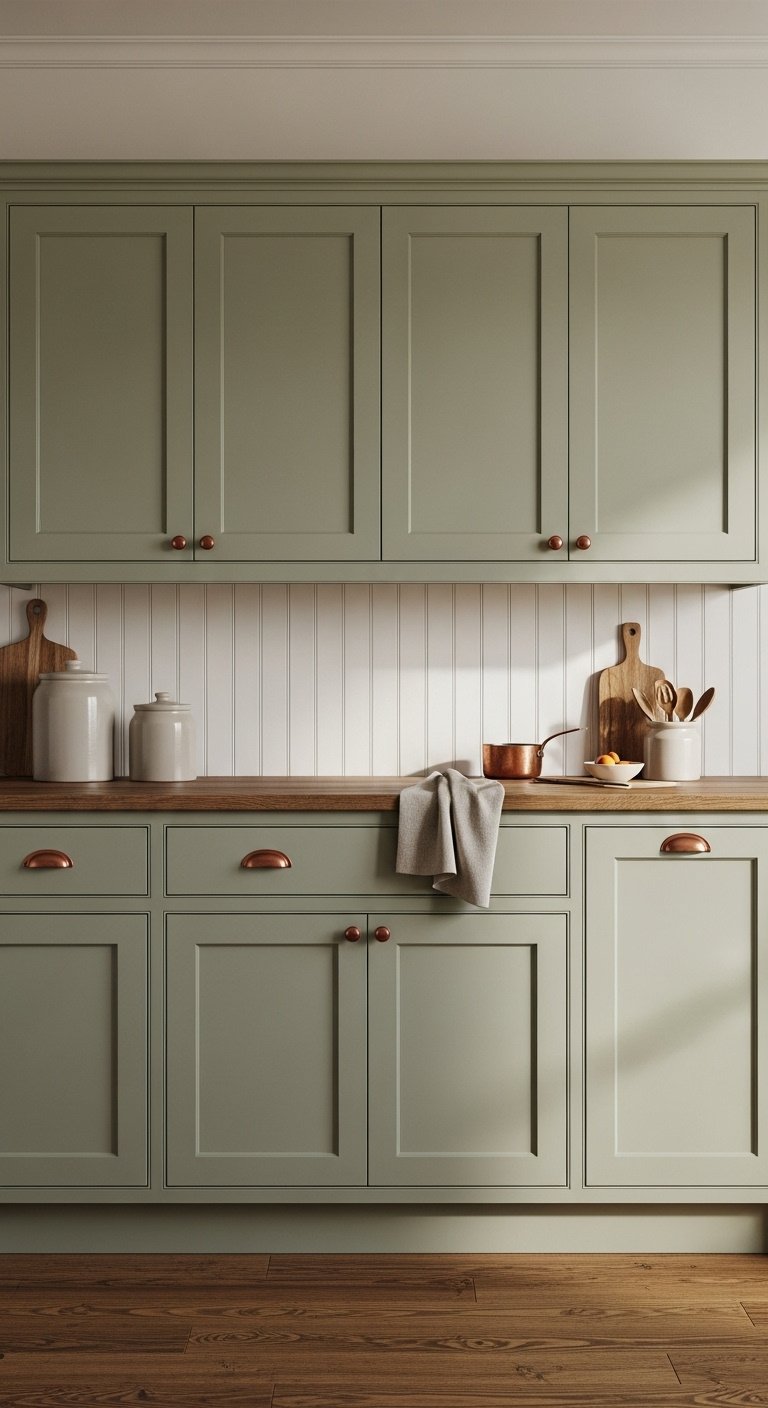
- Materials Needed: High-quality cabinet paint in a sage green shade (e.g., Magnolia Home’s “Cottage Grove” or Farrow & Ball’s “Pigeon”), primer, sanding block, natural wood or leather cabinet pulls.
- Step-by-Step Directions:
- Follow the standard cabinet painting prep: clean, sand, and prime all surfaces for the best adhesion.
- Apply two to three thin coats of your chosen sage green paint for full, even coverage.
- Once the paint is fully cured, install natural-textured hardware like simple wooden knobs or tan leather pulls to enhance the earthy aesthetic.
- This color pairs exceptionally well with warm butcher block countertops and hardwood floors to create a cohesive, natural feel.
Pro-Tip: Sage green is a color chameleon. In rooms with lots of natural light, it appears lighter and more airy. In lower light, it becomes cozier and more dramatic. Test a sample on your cabinet door and observe it throughout the day before committing.
“Add a touch of nature to your kitchen. Save this sage green idea!”
5. Create Character with Open Shelving
Replace some or all of your upper cabinets with open shelving to create an airy, casual, and personalized feel. This is a hallmark of the farmhouse style, allowing you to display everyday dishes, glassware, and favorite decor items. Using thick planks of reclaimed wood adds an extra layer of rustic charm.
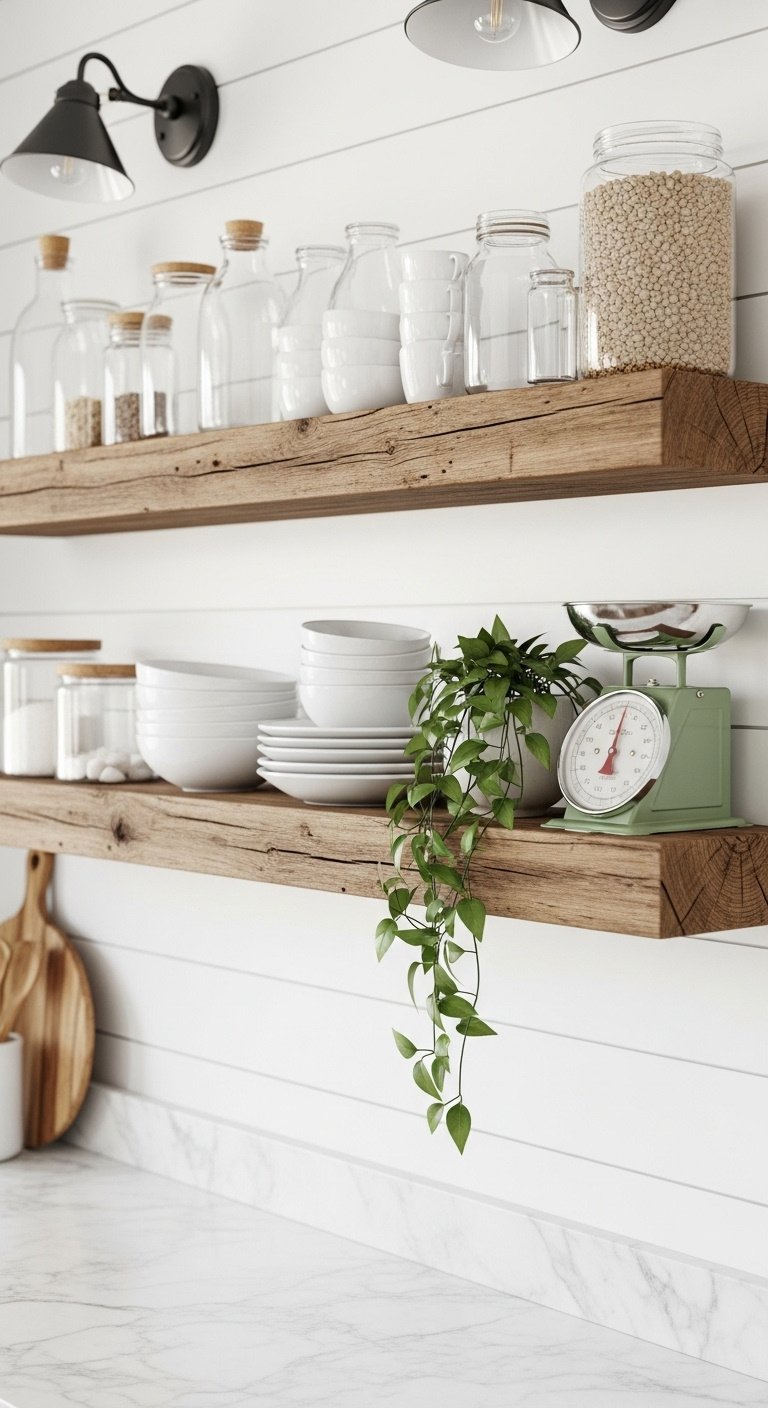
- Materials Needed: Thick wood planks (reclaimed or new), heavy-duty shelf brackets (matte black or brass), a stud finder, a level, and a drill.
- Step-by-Step Directions:
- Carefully remove existing upper cabinets. Patch and paint the wall as needed for a clean slate.
- Use a stud finder to locate the wall studs. This is critical for secure mounting that can hold the weight of dishes. Mark your bracket locations.
- Use a level to ensure your brackets are perfectly aligned before screwing them firmly into the studs.
- Place your wood plank on the brackets and secure it from below if the brackets require it.
- Style your shelves: Stack everyday dishes for easy access, and add personality with small plants, vintage finds, and your favorite cookbooks.
Lesson Learned: The key to successful open shelving is curation. Don’t overcrowd them. Stick to a consistent color palette for your dishware (e.g., all white or cream) to avoid a cluttered, chaotic look.
“Ready to show off your style? Pin this open shelving idea!”
6. Add Texture with Beadboard Cabinet Doors
For a dose of vintage, country charm, incorporate beadboard into your cabinet doors. This simple textural detail instantly evokes a sense of history and coziness. You can either find cabinet doors with integrated beadboard or add it yourself to the flat panel of an existing Shaker-style door for a budget-friendly DIY upgrade.
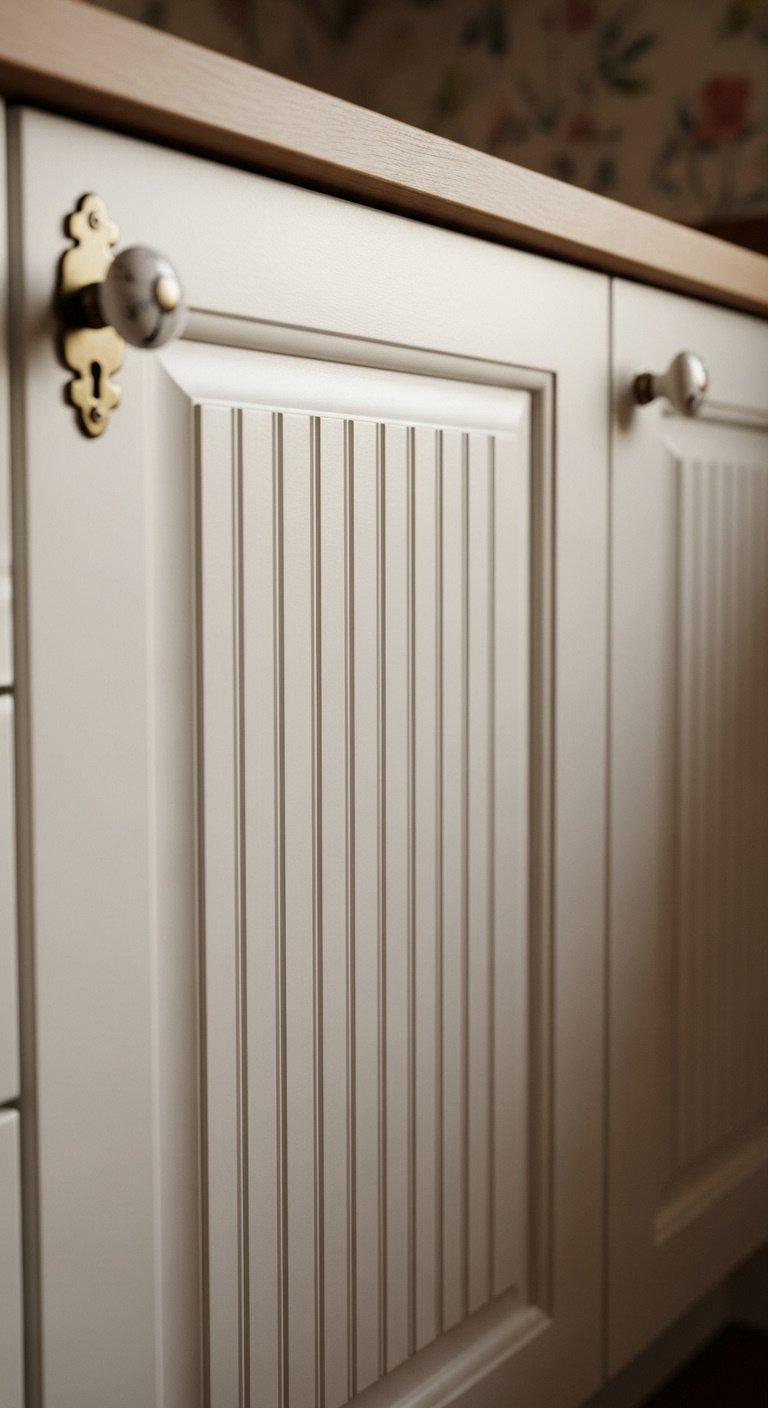
- Materials Needed: Beadboard paneling, liquid nails or wood glue, brad nailer, circular saw, your choice of cabinet paint.
- Step-by-Step Directions:
- This DIY trick works best for Shaker-style doors that already have a flat, recessed center panel.
- Carefully measure the inside dimensions of the flat panel on your cabinet door.
- Cut the beadboard paneling to size. Ensure the “beads” or grooves are running vertically for the classic look.
- Apply a thin layer of liquid nails to the back of the beadboard panel and press it firmly into the cabinet door’s inset panel.
- Secure the panel with a few brad nails around the perimeter for extra hold.
- Fill the nail holes, then prime and paint the entire door for a seamless, custom look.
Pro-Tip: For a truly custom look, run the beadboard on the wall as your backsplash to match the texture on your new cabinet doors. This creates a beautifully cohesive and charming effect.
“Love this charming detail? Save it to your ‘Cottage Kitchen’ board!”
7. Go Bold with Dramatic & Moody Hues
Create a sophisticated and modern take on the farmhouse style by painting cabinets in a dark, moody color like black, charcoal gray, navy blue, or deep forest green. This bold choice creates a stunning contrast, especially when paired with light countertops, a simple backsplash, and warm metallic hardware like unlacquered brass.
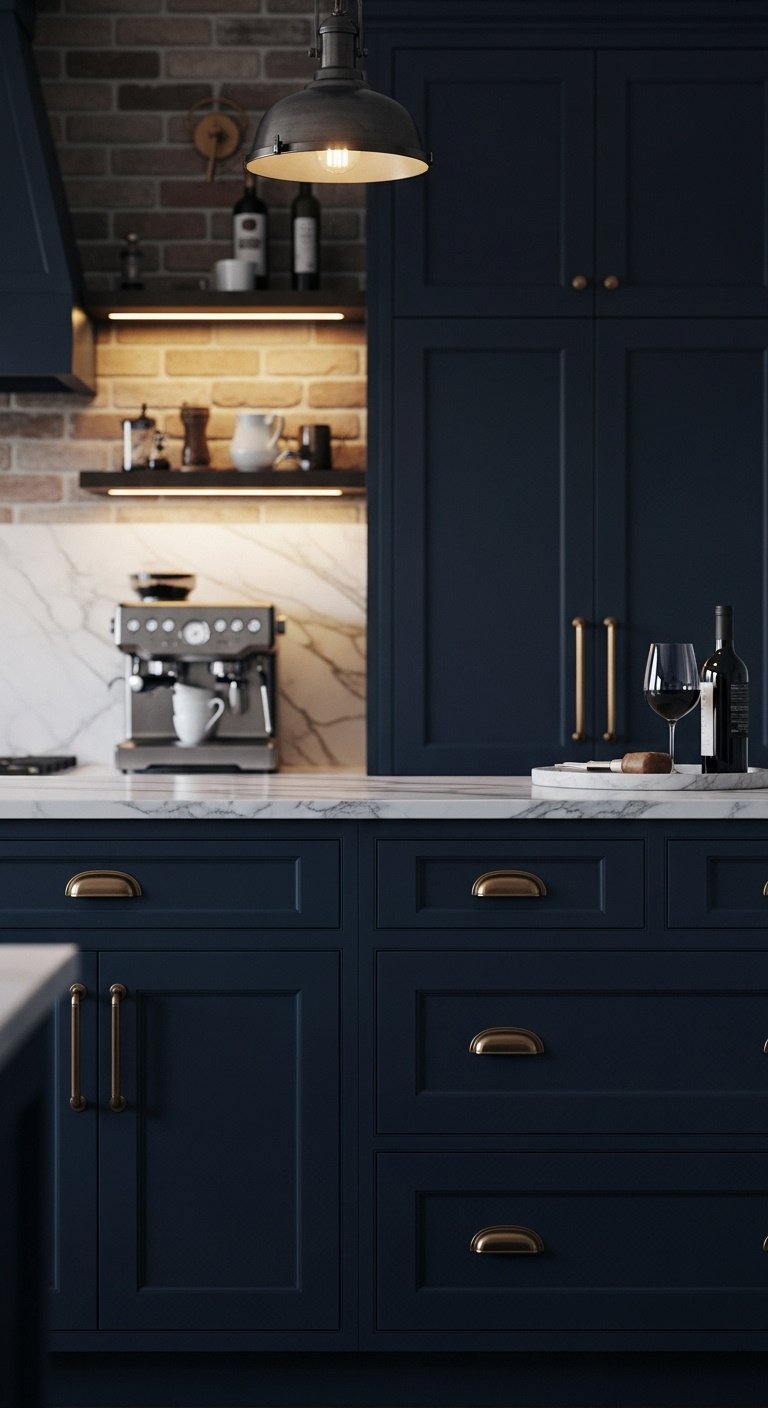
- Materials Needed: High-quality paint in a dark hue (e.g., Benjamin Moore “Hale Navy” or Sherwin-Williams “Iron Ore”), a satin or matte finish topcoat, and a high-quality primer (tinted gray is best for dark colors).
- Step-by-Step Directions:
- Dark colors are less forgiving, so impeccable prep is key. Clean, sand, and fill any imperfections meticulously.
- Use a gray-tinted primer. This will help you achieve a deep, rich final color with fewer coats of paint.
- Apply 2-3 thin coats of your dark paint, allowing ample dry time between each coat to avoid streaks.
- Finish with a durable topcoat to protect against scratches and scuffs, which are more visible on dark surfaces.
- Pair with bright brass hardware and light countertops to create a stunning contrast and prevent the space from feeling too heavy or small.
Lesson Learned: A kitchen with dark cabinets requires excellent lighting. Ensure you have ample task lighting under the cabinets and consider adding statement pendant lights over an island to keep the space functional and bright.
“Feeling bold? Pin this moody kitchen inspiration now!”
8. The Vintage Charm of Glass-Front Cabinets
Add a touch of vintage elegance and a place to display treasures by incorporating glass-front cabinets. Often used for a few select upper cabinets, this style breaks up the monotony of solid doors and adds a lighter, more decorative element. Mullioned doors (those with grilles) enhance the classic farmhouse feel.
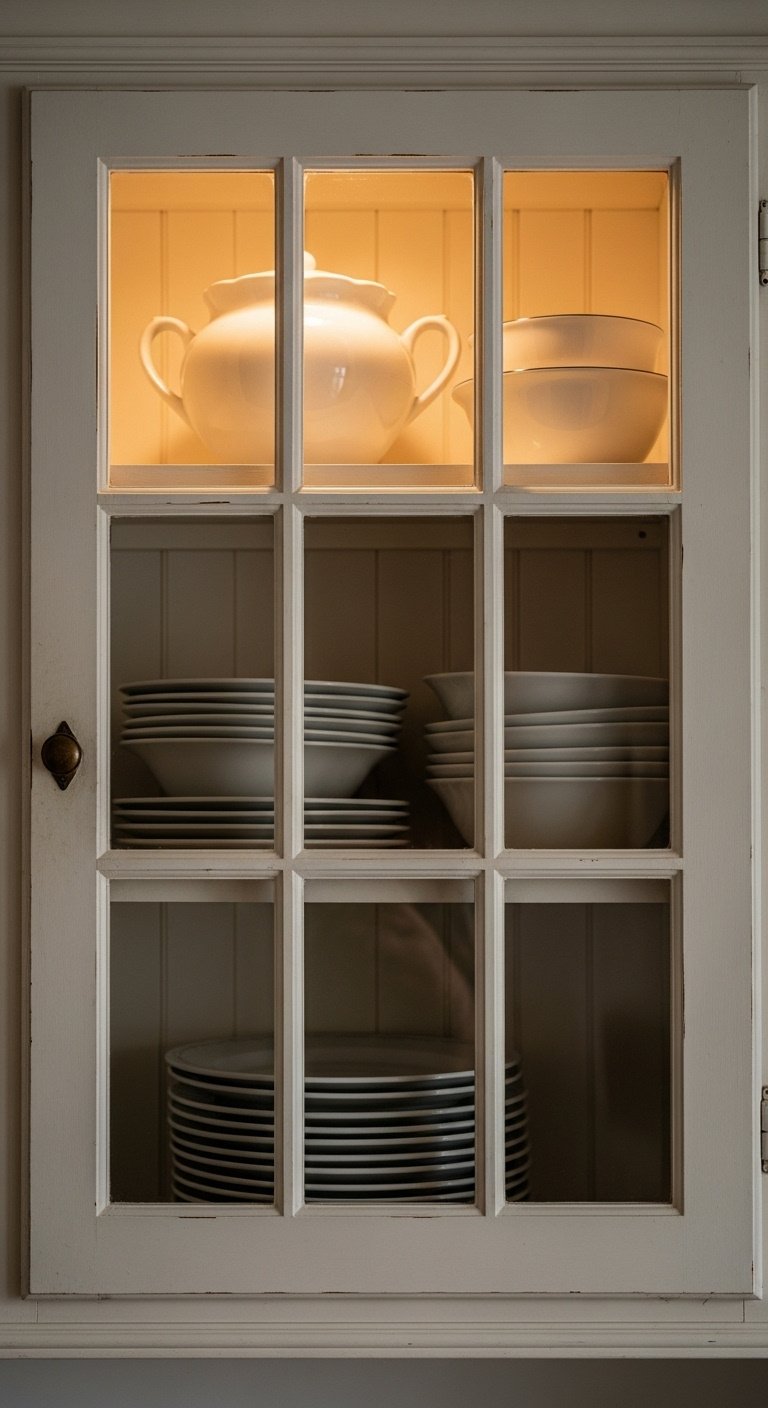
- Materials Needed: Pre-made glass-front cabinet doors (or a router and glass panels for a DIY approach), small hinges, magnetic catches, LED puck lights or strip lighting.
- Step-by-Step Directions:
- Replace a few existing solid upper cabinet doors with glass-front doors. Choose doors with mullions for a classic farmhouse look.
- Elevate the look by painting the interior of the cabinet a contrasting color or applying a subtle wallpaper for added interest.
- Install small, battery-operated or hardwired LED lights at the top of the cabinet interior to illuminate your display and create a beautiful evening glow.
- Arrange your most beautiful glassware, china, and serving pieces inside.
Pro-Tip: Don’t have a perfect set of matching dishes? No problem. Use glass-front cabinets to store other beautiful items like stacks of cookbooks, vintage pitchers, or a collection of matching canisters for flour and sugar.
“Showcase your treasures! Save this glass-front cabinet idea.”
9. The Rustic Appeal of Reclaimed Wood
For the most authentic rustic look, use reclaimed wood for your cabinet fronts or a kitchen island. Materials like old barn wood or hickory bring unparalleled texture, history, and character to a kitchen. Each knot, nail hole, and saw mark tells a story, creating a space that feels truly one-of-a-kind.
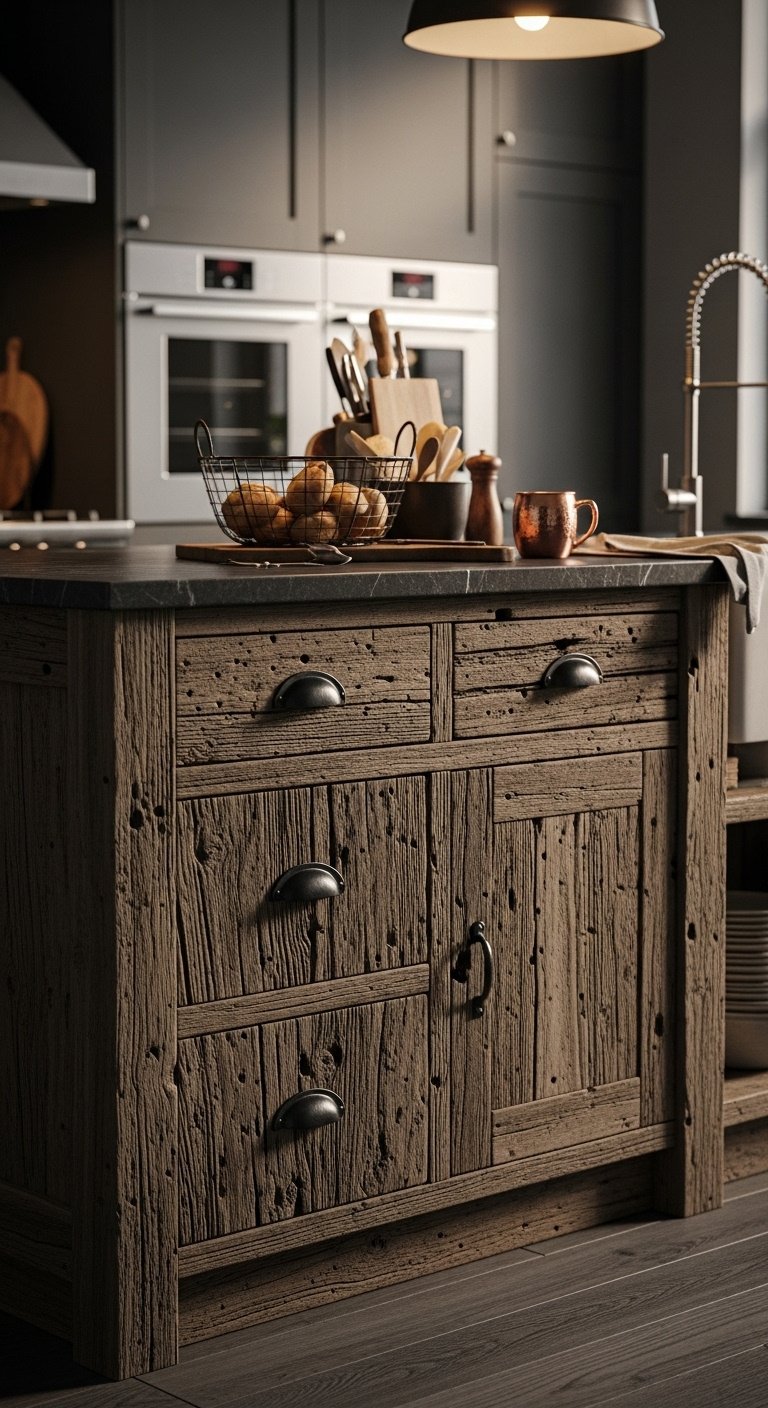
- Materials Needed: Reclaimed wood planks, plywood for cabinet boxes, heavy-duty hinges, cast iron hardware.
- Step-by-Step Directions:
- This is a more advanced DIY or custom project. Source reclaimed wood from a reputable dealer to ensure it’s properly treated and safe for indoor use.
- Construct simple, sturdy cabinet boxes from plywood.
- Clad the exterior sides and create flat-panel doors using the reclaimed wood planks.
- Embrace the imperfections—the nail holes, knots, and color variations are what give the wood its character.
- Seal the wood with a matte, water-based polyurethane. This protects it from kitchen splashes without adding a high-gloss shine that would detract from its rustic nature.
- Finish with substantial, hand-forged or cast iron hardware that complements the ruggedness of the wood.
Lesson Learned: True reclaimed wood can be uneven. When building doors, it’s wise to use a stable backing board (like thin plywood painted black) to ensure stability and prevent warping over time in the fluctuating humidity of a kitchen.
“Bring history into your home. Pin this reclaimed wood idea!”
10. The Unfitted Look: Freestanding Cabinets
Achieve a collected-over-time, European farmhouse look by incorporating freestanding furniture pieces instead of a full wall of built-in cabinets. A vintage hutch, a standalone pantry cabinet, or a painted sideboard can serve as functional storage while adding immense character and breaking up the uniformity of a typical kitchen layout.
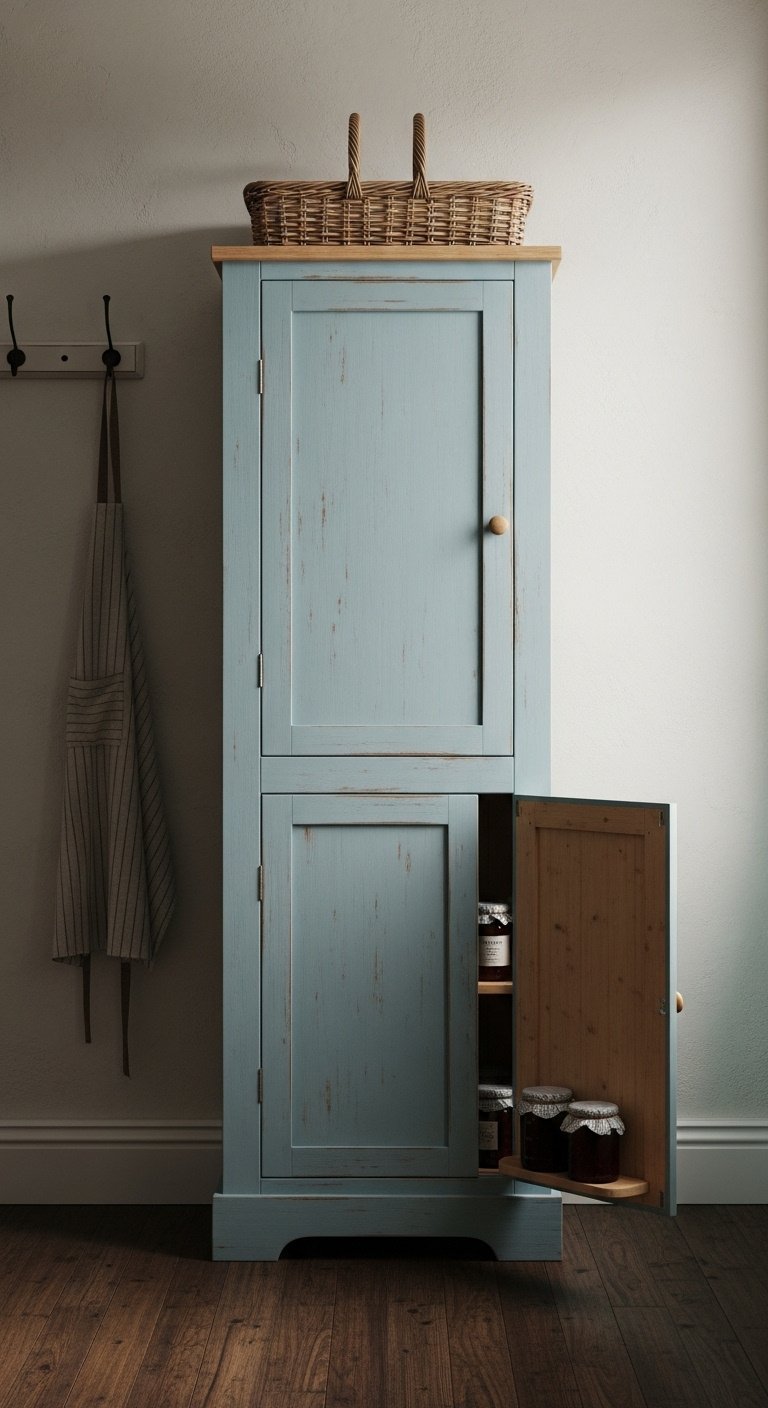
- Materials Needed: A vintage or new freestanding cabinet piece (e.g., a tall pantry cabinet or a low sideboard), furniture anchors/straps for safety.
- Step-by-Step Directions:
- Break up a long wall of standard built-in cabinets by leaving a space to incorporate a freestanding piece.
- Search antique stores, flea markets, or online marketplaces for a vintage hutch or sideboard that you can paint to match or contrast with your existing cabinets.
- Use a tall, freestanding pantry cabinet as a beautiful and functional focal point for storing dry goods.
- Place a lower sideboard or dresser in the kitchen to serve as a coffee station or to store extra dishes and linens.
- Crucially, always use furniture anchors to secure any tall or heavy pieces to the wall to prevent tipping, especially in homes with children.
Pro-Tip: The ‘unfitted’ look is all about mixing and matching. Don’t be afraid to pair a sleek, modern countertop on your main cabinets with a distressed, vintage hutch. The contrast is what creates the charm and personality.
“Think outside the (cabinet) box! Save this unique idea.”
11. Subtle Contrast with Greige and Mushroom Tones
For a sophisticated neutral that’s warmer than gray but more modern than beige, choose a greige or mushroom color. These complex neutrals create a soft, elegant, and calming atmosphere. They are incredibly versatile and pair beautifully with a wide range of materials, from warm woods to cool marbles, and hardware finishes like champagne bronze.
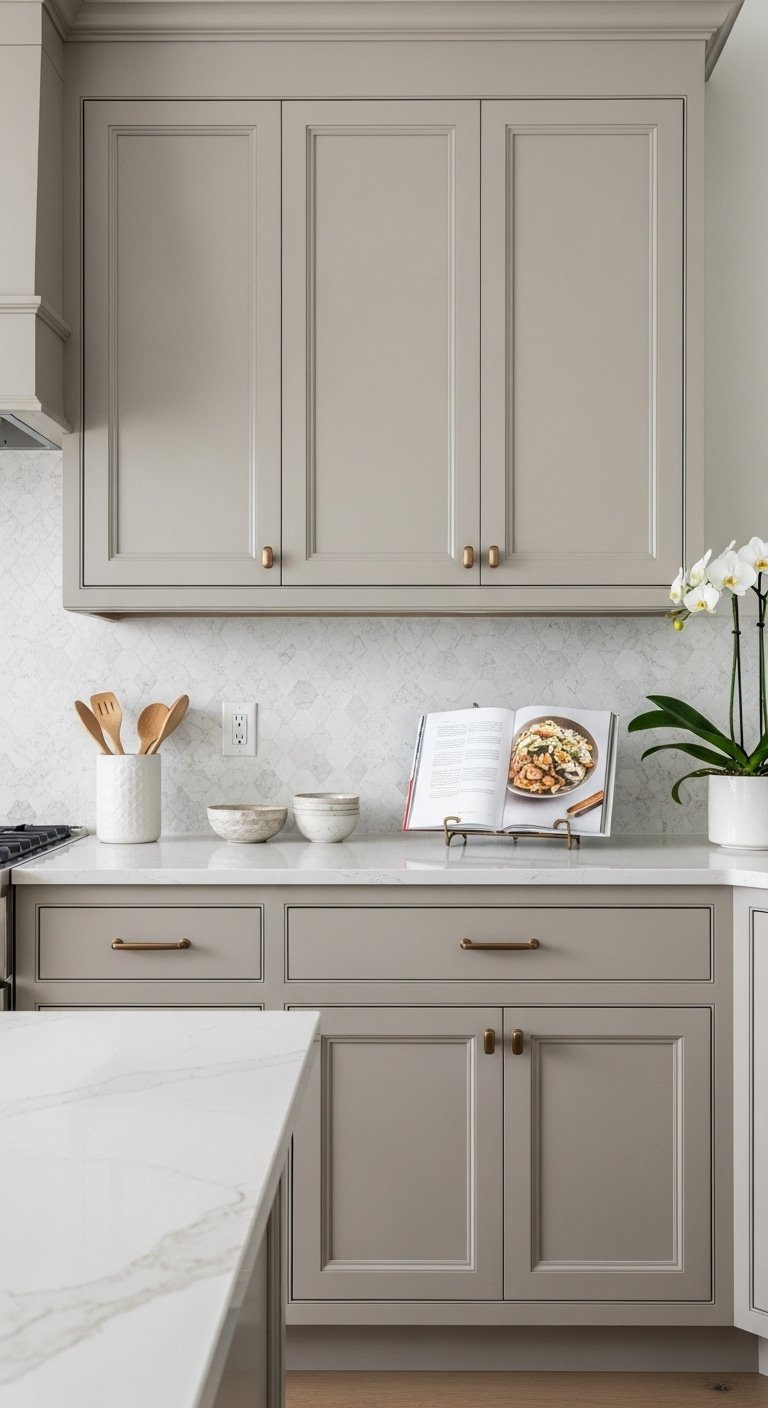
- Materials Needed: High-quality cabinet paint in a greige or mushroom shade (e.g., Sherwin-Williams “Accessible Beige” or Farrow & Ball “Elephant’s Breath”), a satin or matte finish, and champagne bronze hardware.
- Step-by-Step Directions:
- Prep, prime, and paint your cabinets following standard procedures. These mid-tones provide excellent coverage and are very forgiving.
- Pair with hardware in a warm metallic finish like champagne bronze or brushed brass. This brings out the warm undertones in the paint and adds a touch of luxury.
- Complement the look with a backsplash that has natural texture and subtle color variation, such as handmade Zellige tile, to keep the neutral palette from feeling flat or one-dimensional.
Lesson Learned: Greige is the ultimate neutral. It adapts to the light in your room, looking slightly cooler in north-facing light and warmer in south-facing light. It’s a perfect bridge between warm wood floors and cool stainless steel appliances, tying the whole room together.
“For a look that’s perfectly understated, pin this greige kitchen!”
Key Takeaways: Your Quick Guide to farmhouse kitchen cabinets
Feeling inspired? Here are the most important principles to remember as you plan your modern farmhouse kitchen cabinet project.
- Embrace Shaker Style: The clean, simple lines of Shaker cabinets are the perfect foundation for the modern farmhouse look. They are timeless and versatile.
- Go for Neutral or Natural: Classic white is a can’t-miss choice, but don’t be afraid to explore warm woods, earthy greens, moody blues, or sophisticated greiges to add personality.
- Hardware is Key: The right hardware acts like jewelry for your cabinets. Matte black, oil-rubbed bronze, or unlacquered brass can instantly transform the look and feel of your kitchen.
- Mix Old and New: Contrast is your friend. Pair rustic reclaimed wood with sleek quartz countertops, or modern dark-painted cabinets with vintage-style hardware to create a dynamic space.
- Add Texture: To avoid a flat look, incorporate elements like beadboard doors, open shelving with curated decor, or a textured backsplash to add character, depth, and warmth.
People Also Ask About farmhouse kitchen cabinets
What defines farmhouse-style cabinets?
Farmhouse-style cabinets are primarily defined by their simple, practical, and durable construction. The most iconic style is the Shaker cabinet, featuring a flat center panel with a raised, square-edged frame. They are usually made of wood, painted in neutral colors like white, gray, or soft greens, and finished with simple, unornamented hardware like bin pulls or knobs.
What is the best color for a farmhouse kitchen?
White is the most classic and popular color for a farmhouse kitchen, as it creates a bright, clean, and airy feel. However, other colors are also very popular in modern designs, including soft grays, greiges, sage greens, and deep navy blues, especially when used on lower cabinets or a kitchen island to add a modern, contrasting touch.
What color does Joanna Gaines use for kitchen cabinets?
Joanna Gaines often uses classic whites and neutrals but is also known for incorporating earthy greens and moody blue-greens. A notable color is “Cottage Grove” from her Magnolia Home line, which she describes as a dramatic and cozy mix of navy and green. This highlights the modern farmhouse trend of using nature-inspired colors as bold accents.
Are wood cabinets in style for a farmhouse kitchen?
Absolutely. Natural wood cabinets are very much in style for modern farmhouse kitchens, updated for 2025. Lighter woods like white oak are especially popular for creating a warm, airy, and slightly Scandinavian-inspired feel. Pairing natural wood cabinets with white countertops and simple, modern hardware keeps the look fresh, current, and far from dated.
Final Thoughts
Creating a cozy, modern farmhouse kitchen is all about blending timeless elements with your personal style. It’s a look that celebrates practicality, embraces imperfection, and creates a warm welcome for everyone who enters. Whether you go for a simple hardware update or a full color change, these ideas can help you build a space you’ll love for years to come.
Which of these cabinet ideas is your absolute favorite? Let us know in the comments below
